“Listen, my children, and you shall hear
Of the midnight ride of Paul Revere,
On the eighteenth of April, in Seventy-Five:
Hardly a man is now alive
Who remembers that famous day and year.”
So begins Henry Wadsworth Longfellow’s famous poem, immortalizing one of the pivotal moments in American history—the ride of Paul Revere. In the early hours of April 18, 1775, Paul Revere embarked on a daring journey that would become legendary, marking the beginning of the American Revolutionary War.
Paul Revere, a silversmith and patriot, was deeply involved in the cause of American independence. Living in Boston, he was a member of the Sons of Liberty, a secret organization dedicated to opposing British rule. Revere was well-connected and trusted within these circles, making him an ideal messenger for the colonial cause.
On that famous evening, Revere received word that British troops were planning to march from Boston to the nearby towns of Lexington and Concord. Their mission was to seize colonial weapons and arrest rebel leaders, notably Samuel Adams and John Hancock. Sensing the urgency of the situation, Revere knew he had to act swiftly to warn the countryside of the impending danger.
Mounted on his horse, Revere set out into the night, riding through the streets of Boston and across the Charles River to Charlestown. Along the way, he alerted patriots and militia members, shouting warnings and banging on doors. Revere’s cry, “The British are coming! The British are coming!” echoed through the darkness, galvanizing the colonists to action.
Revere wasn’t alone in his mission. William Dawes and Samuel Prescott, fellow riders, joined him along the way, spreading the alarm to as many towns and villages as possible. Despite facing obstacles such as British patrols and treacherous terrain, Revere pressed on, knowing that the fate of the revolution hung in the balance.
As dawn approached, Revere reached Lexington, where he delivered his warning to Adams and Hancock, allowing them to escape capture. However, the British were already on the move, and the first shots of the Revolutionary War would soon be fired on Lexington Green.
Although Revere’s ride was just one part of a larger network of messengers and warnings, its impact cannot be overstated. By alerting the countryside to the British advance, Revere helped to mobilize the colonial militia, ensuring that they were prepared to defend their rights and liberties.
Longfellow’s poem, published nearly a century later in 1861, transformed Revere’s ride into a symbol of American heroism and defiance. Through its vivid imagery and stirring verse, the poem captured the imagination of generations, cementing Revere’s place in the pantheon of American folklore.
Yet, like many historical events, the true story of Paul Revere’s ride is more complex than the legend suggests. Revere himself downplayed his role, emphasizing the collective effort of the patriots rather than his individual actions. In reality, it was the coordinated efforts of many riders, including Dawes and Prescott, that spread the alarm that fateful night.
Nevertheless, Paul Revere’s name endures as a symbol of courage and patriotism, reminding us of the sacrifices made by ordinary people in the fight for freedom.






